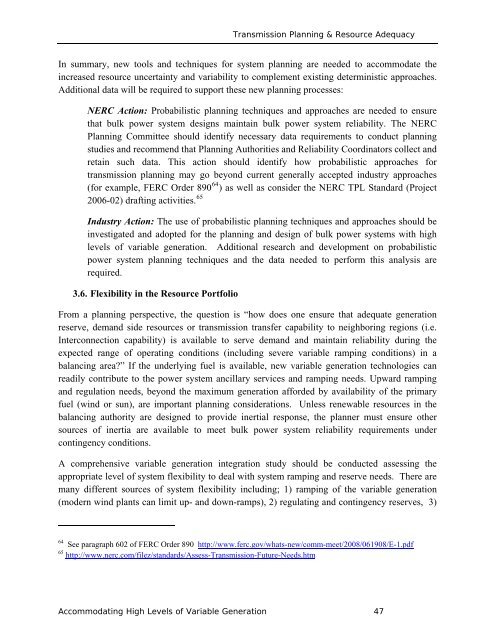Accommodating High Levels of Variable Generation - NERC
Accommodating High Levels of Variable Generation - NERC
Accommodating High Levels of Variable Generation - NERC
You also want an ePaper? Increase the reach of your titles
YUMPU automatically turns print PDFs into web optimized ePapers that Google loves.
Transmission Planning & Resource Adequacy<br />
In summary, new tools and techniques for system planning are needed to accommodate the<br />
increased resource uncertainty and variability to complement existing deterministic approaches.<br />
Additional data will be required to support these new planning processes:<br />
<strong>NERC</strong> Action: Probabilistic planning techniques and approaches are needed to ensure<br />
that bulk power system designs maintain bulk power system reliability. The <strong>NERC</strong><br />
Planning Committee should identify necessary data requirements to conduct planning<br />
studies and recommend that Planning Authorities and Reliability Coordinators collect and<br />
retain such data. This action should identify how probabilistic approaches for<br />
transmission planning may go beyond current generally accepted industry approaches<br />
(for example, FERC Order 890 64 ) as well as consider the <strong>NERC</strong> TPL Standard (Project<br />
2006-02) drafting activities. 65<br />
Industry Action: The use <strong>of</strong> probabilistic planning techniques and approaches should be<br />
investigated and adopted for the planning and design <strong>of</strong> bulk power systems with high<br />
levels <strong>of</strong> variable generation. Additional research and development on probabilistic<br />
power system planning techniques and the data needed to perform this analysis are<br />
required.<br />
3.6. Flexibility in the Resource Portfolio<br />
From a planning perspective, the question is “how does one ensure that adequate generation<br />
reserve, demand side resources or transmission transfer capability to neighboring regions (i.e.<br />
Interconnection capability) is available to serve demand and maintain reliability during the<br />
expected range <strong>of</strong> operating conditions (including severe variable ramping conditions) in a<br />
balancing area?” If the underlying fuel is available, new variable generation technologies can<br />
readily contribute to the power system ancillary services and ramping needs. Upward ramping<br />
and regulation needs, beyond the maximum generation afforded by availability <strong>of</strong> the primary<br />
fuel (wind or sun), are important planning considerations. Unless renewable resources in the<br />
balancing authority are designed to provide inertial response, the planner must ensure other<br />
sources <strong>of</strong> inertia are available to meet bulk power system reliability requirements under<br />
contingency conditions.<br />
A comprehensive variable generation integration study should be conducted assessing the<br />
appropriate level <strong>of</strong> system flexibility to deal with system ramping and reserve needs. There are<br />
many different sources <strong>of</strong> system flexibility including; 1) ramping <strong>of</strong> the variable generation<br />
(modern wind plants can limit up- and down-ramps), 2) regulating and contingency reserves, 3)<br />
64 See paragraph 602 <strong>of</strong> FERC Order 890 http://www.ferc.gov/whats-new/comm-meet/2008/061908/E-1.pdf<br />
65 http://www.nerc.com/filez/standards/Assess-Transmission-Future-Needs.htm<br />
<strong>Accommodating</strong> <strong>High</strong> <strong>Levels</strong> <strong>of</strong> <strong>Variable</strong> <strong>Generation</strong> 47
















